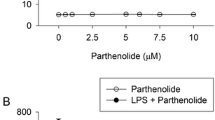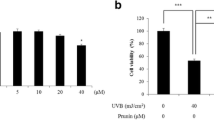Abstract
The anti-inflammatory effects of a 50% aqueous extract of Rosa roxburghii fruit (RRFE) and two ellagitannins (strictinin and casuarictin) isolated from the RRFE were evaluated in a cell model of skin inflammation induced by self-RNA released from epidermal cells damaged by UV ray (UVR) irradiation. The RRFE inhibited interleukin-8 (IL-8) mRNA expression in normal human epidermal keratinocytes (NHEKs) stimulated with polyinosinic:polycytidylic acid (poly(I:C)), a ligand of toll-like receptor-3 (TLR-3). The plant-derived anti-inflammatory agents, dipotassium glycyrrhizinate (GK2) and allantoin, had no influence on the IL-8 expression. The purified compounds, strictinin and casuarictin, inhibited the IL-8 mRNA expression and IL-8 release induced in NHEKs by poly(I:C). These ellagitannins were thus found to be responsible for the biological activity exhibited by the RRFE. This study demonstrates that RRFE and isolated RRFE compounds show promise as ingredients for products formulated to improve skin disorders induced by UVR irradiation.






Similar content being viewed by others
References
McGregor JM, Hawk JLM (1999) Acute effects of ultraviolet radiation on the skin. In: Freedberg IM, Eisen AZ, Wolff K, Austen KF, Goldsmith LA, Katz SI, Fitzpatrick TB (eds) Dermatology in general medicine, vol 5. McGraw-Hill, New York, pp 1562–1568
Gilchrest BA (1989) Skin aging and photoaging: an overview. J Am Acad Dermatol 21:610–613. https://doi.org/10.1016/s0190-9622(89)70227-9
Ansel JC, Luger TA, Green I (1983) The effect of in vitro and in vivo UV irradiation on the production of ETAF activity by human and murine keratinocytes. J Invest Dermatol 81:519–523. https://doi.org/10.1111/1523-1747.ep12522862
Luger TA, Sztein MB, Schmidt JA, Murphy P, Grabner G, Oppenheim JJ (1983) Properties of murine and human epidermal cell-derived thymocyte-activating factor. Fed Proc 42:2772–2776
Urbanski A, Schwarz T, Neuner P, Krutmann J, Kirnbauer R, Kock A, Luger TA (1990) Ultraviolet light induces increased circulating interleukin-6 in humans. J Invest Dermatol 94:808–811. https://doi.org/10.1111/1523-1747.ep12874666
Oxholm A, Oxholm P, Staberg B, Bendtzen K (1988) Immunohistological detection of interleukin I-like molecules and tumor necrosis factor in human epidermis before and after UVB-irradiation in vivo. Br J Dermatol 118:369–376. https://doi.org/10.1111/j.1365-2133.1988.tb02430.x
Kock A, Schwarz T, Kirnbauer R, Urbanski A, Perry P, Ansel JC, Luger TA (1990) Human keratinocytes are a source for tumor necrosis factor alpha: evidence for synthesis and release upon stimulation with endotoxin or ultraviolet light. J Exp Med 172:1609–1614. https://doi.org/10.1084/jem.172.6.1609
Kondo S, Kono T, Sauder DN, McKenzie RC (1993) IL-8 gene expression and production in human keratinocytes and their modulation by UVB. J Invest Dermatol 101:690–694. https://doi.org/10.1111/1523-1747.ep12371677
Clydesdale GJ, Dandie GW, Muller HK (2001) Ultraviolet light induced injury: immunological and inflammatory effects. Immunol Cell Biol 79:547–568. https://doi.org/10.1046/j.1440-1711.2001.01047.x
Cooper KD, Duraiswamy N, Hammerberg C, Allen E, Kimbrough-Green C, Dillon W, Thomas D (1993) Neutrophils, differentiated macrophages, and monocyte/macrophage antigen presenting cells infiltrate murine epidermis after UV injury. J Invest Dermatol 101:155–163. https://doi.org/10.1111/1523-1747.ep12363639
Ouhtit A, Muller HK, Davis DW, Ullrich SE, McConkey D, Ananthaswamy HN (2000) Temporal events in skin injury and the early adaptive responses in ultraviolet-irradiated mouse skin. Am J Pathol 156:201–207. https://doi.org/10.1016/s0002-9440(10)64720-7
Bernard JJ, Cowing-Zitron C, Nakatsuji T, Muehleisen B, Muto J, Borkowski AW, Martinez L, Greidinger EL, Yu BD, Gallo RL (2012) Ultraviolet radiation damages self noncoding RNA and is detected by TLR3. Nat Med 18:1286–1290. https://doi.org/10.1038/nm.2861
Vu AT, Chen X, Xie Y, Kamijo S, Ushio H, Kawasaki J, Hara M, Ikeda S, Okumura K, Ogawa H, Takai T (2011) Extracellular double-stranded RNA induces TSLP via an endosomal acidification- and NF-kappaB-dependent pathway in human keratinocytes. J Invest Dermatol 131:2205–2212. https://doi.org/10.1038/jid.2011.185
Alvarez-Suarez JM, Dekanski D, Ristic S, Radonjic NV, Petronijevic ND, Giampieri F, Astolfi P, Gonzalez-Paramas AM, Santos-Buelga C, Tulipani S, Quiles JL, Mezzetti B, Battino M (2011) Strawberry polyphenols attenuate ethanol-induced gastric lesions in rats by activation of antioxidant enzymes and attenuation of MDA increase. PLoS ONE 6:e25878. https://doi.org/10.1371/journal.pone.0025878
Edirisinghe I, Banaszewski K, Cappozzo J, Sandhya K, Ellis CL, Tadapaneni R, Kappagoda CT, Burton-Freeman BM (2011) Strawberry anthocyanin and its association with postprandial inflammation and insulin. Br J Nutr 106:913–922. https://doi.org/10.1017/S0007114511001176
Joseph SV, Edirisinghe I, Burton-Freeman BM (2014) Berries: anti-inflammatory effects in humans. J Agric Food Chem 62:3886–3903. https://doi.org/10.1021/jf4044056
Zunino SJ, Parelman MA, Freytag TL, Stephensen CB, Kelley DS, Mackey BE, Woodhouse LR, Bonnel EL (2012) Effects of dietary strawberry powder on blood lipids and inflammatory markers in obese human subjects. Br J Nutr 108:900–909. https://doi.org/10.1017/S0007114511006027
Parelman MA, Storms DH, Kirschke CP, Huang L, Zunino SJ (2012) Dietary strawberry powder reduces blood glucose concentrations in obese and lean C57BL/6 mice, and selectively lowers plasma C-reactive protein in lean mice. Br J Nutr 108:1789–1799. https://doi.org/10.1017/S0007114512000037
Koponen JM, Happonen AM, Mattila PH, Torronen AR (2007) Contents of anthocyanins and ellagitannins in selected foods consumed in Finland. J Agric Food Chem 55:1612–1619. https://doi.org/10.1021/jf062897a
Fumagalli M, Sangiovanni E, Vrhovsek U, Piazza S, Colombo E, Gasperotti M, Mattivi F, De Fabiani E, Dell’Agli M (2016) Strawberry tannins inhibit IL-8 secretion in a cell model of gastric inflammation. Pharmacol Res 111:703–712. https://doi.org/10.1016/j.phrs.2016.07.028
Duke JA, Ayensu ES (1985) Medicinal plants of China. Reference Publications Inc, Algonac, Michigan
Yoshida T, Chen XM, Hatano T, Fukushima M, Okuda T (1987) Tannins and related polyphenols of Rosaceous medicinal plants. IV. Roxbins A and B from Rosa roxburghii fruits. Chem Pharm Bull 35:1817–1822
Borkowski AW, Park K, Uchida Y, Gallo RL (2013) Activation of TLR3 in keratinocytes increases expression of genes involved in formation of the epidermis, lipid accumulation, and epidermal organelles. J Invest Dermatol 133:2031–2040. https://doi.org/10.1038/jid.2013.39
Puglia C, Rizza L, Offerta A, Gasparri F, Giannini V, Bonina F (2013) Formulation strategies to modulate the topical delivery of anti-inflammatory compounds. J Cosmet Sci 64:341–353
Draelos ZD (2016) A pilot study investigating the efficacy of botanical anti-inflammatory agents in an OTC eczema therapy. J Cosmet Dermatol 15:117–119. https://doi.org/10.1111/jocd.12199
Borkowski AW, Gallo RL (2014) UVB radiation illuminates the role of TLR3 in the epidermis. J Invest Dermatol 134:2315–2320. https://doi.org/10.1038/jid.2014.167
Norris DA, Lyons MB, Middleton MH, Yohn JJ, Kashihara-Sawami M (1990) Ultraviolet radiation can either suppress or induce expression of intercellular adhesion molecule 1 (ICAM-1) on the surface of cultured human keratinocytes. J Invest Dermatol 95:132–138. https://doi.org/10.1111/1523-1747.ep12477877
Strickland I, Rhodes LE, Flanagan BF, Friedmann PS (1997) TNF-alpha and IL-8 are upregulated in the epidermis of normal human skin after UVB exposure: correlation with neutrophil accumulation and E-selectin expression. J Invest Dermatol 108:763–768. https://doi.org/10.1111/1523-1747.ep12292156
Lee CJ, Chen LG, Liang WL, Wang CC (2010) Anti-inflammatory effects of Punica granatum Linne in vitro and in vivo. Food Chem 118:315–322. https://doi.org/10.1016/j.foodchem.2009.04.123
Moharram FA, Al-Gendy AA, El-Shenawy SM et al (2018) Phenolic profile, anti-inflammatory, antinociceptive, anti-ulcerogenic and hepatoprotective activities of Pimenta racemosa leaves. BMC Complement Altern Med 18:208. https://doi.org/10.1186/s12906-018-2260-3
Shah G, Ghosh R, Amstad PA, Cerutti PA (1993) Mechanism of induction of c-fos by ultraviolet B (290–320 nm) in mouse JB6 epidermal cells. Cancer Res 53:38–45
Mollica L, De Marchis F, Spitaleri A, Dallacosta C, Pennacchini D, Zamai M, Agresti A, Trisciuoglio L, Musco G, Bianchi ME (2007) Glycyrrhizin binds to high-mobility group box 1 protein and inhibits its cytokine activities. Chem Biol 14:431–441. https://doi.org/10.1016/j.chembiol.2007.03.007
Park JS, Svetkauskaite D, He Q, Kim JY, Strassheim D, Ishizaka A, Abraham E (2004) Involvement of toll-like receptors 2 and 4 in cellular activation by high mobility group box 1 protein. J Biol Chem 279:7370–7377. https://doi.org/10.1074/jbc.M306793200
Liliensiek B, Weigand MA, Bierhaus A, Nicklas W, Kasper M, Hofer S, Plachky J, Grone HJ, Kurschus FC, Schmidt AM, Yan SD, Martin E, Schleicher E, Stern DM, Hammerling GG, Nawroth PP, Arnold B (2004) Receptor for advanced glycation end products (RAGE) regulates sepsis but not the adaptive immune response. J Clin Invest 113:1641–1650. https://doi.org/10.1172/JCI18704
Florentino IF, Silva DPB, Galdino PM, Lino RC, Martins JLR, Silva DM, de Paula JR, Tresvenzol LMF, Costa EA (2016) Antinociceptive and anti-inflammatory effects of Memora nodosa and allantoin in mice. J Ethnopharmacol 186:298–304. https://doi.org/10.1016/j.jep.2016.04.010
Bhattacharyya S, Gill R, Chen ML, Zhang F, Linhardt RJ, Dudeja PK, Tobacman JK (2008) Toll-like receptor 4 mediates induction of the Bcl10-NFkappaB-interleukin-8 inflammatory pathway by carrageenan in human intestinal epithelial cells. J Biol Chem 283:10550–10558. https://doi.org/10.1074/jbc.M708833200
Tsuji RF, Hoshino K, Noro Y, Tsuji NM, Kurokawa T, Masuda T, Akira S, Nowak B (2003) Suppression of allergic reaction by lambda-carrageenan: toll-like receptor 4/MyD88-dependent and -independent modulation of immunity. Clin Exp Allergy 33:249–258. https://doi.org/10.1046/j.1365-2222.2003.01575.x
Aries MF, Hernandez-Pigeon H, Vaissiere C, Delga H, Caruana A, Leveque M, Bourrain M, Ravard Helffer K, Chol B, Nguyen T, Bessou-Touya S, Castex-Rizzi N (2016) Anti-inflammatory and immunomodulatory effects of Aquaphilus dolomiae extract on in vitro models. Clin Cosmet Investig Dermatol 9:421–434. https://doi.org/10.2147/CCID.S113180
Grimstad O, Husebye H, Espevik T (2013) TLR3 mediates release of IL-1beta and cell death in keratinocytes in a caspase-4 dependent manner. J Dermatol Sci 72:45–53. https://doi.org/10.1016/j.jdermsci.2013.05.006
Bian ZM, Elner SG, Elner VM (2009) Dual involvement of caspase-4 in inflammatory and ER stress-induced apoptotic responses in human retinal pigment epithelial cells. Invest Ophthalmol Vis Sci 50:6006–6014. https://doi.org/10.1167/iovs.09-3628
Afaq F, Zaid MA, Khan N, Dreher M, Mukhtar H (2009) Protective effect of pomegranate-derived products on UVB-mediated damage in human reconstituted skin. Exp Dermatol 18:553–561. https://doi.org/10.1111/j.1600-0625.2008.00829.x
Acknowledgements
We are grateful to Prof. Hiroshi Ueda at Gifu University for his critical discussion and advice on the preparation of this manuscript. We would like to thank Mr. Simon Johnson for his skillful assistance in the preparation of this manuscript.
Author information
Authors and Affiliations
Corresponding authors
Ethics declarations
Conflict of interests
The authors declare no potential conflicts of interest.
Additional information
Publisher's Note
Springer Nature remains neutral with regard to jurisdictional claims in published maps and institutional affiliations.
Rights and permissions
About this article
Cite this article
Takayama, S., Kawanishi, M., Yamauchi, K. et al. Ellagitannins from Rosa roxburghii suppress poly(I:C)-induced IL-8 production in human keratinocytes. J Nat Med 75, 623–632 (2021). https://doi.org/10.1007/s11418-021-01509-x
Received:
Accepted:
Published:
Issue Date:
DOI: https://doi.org/10.1007/s11418-021-01509-x




